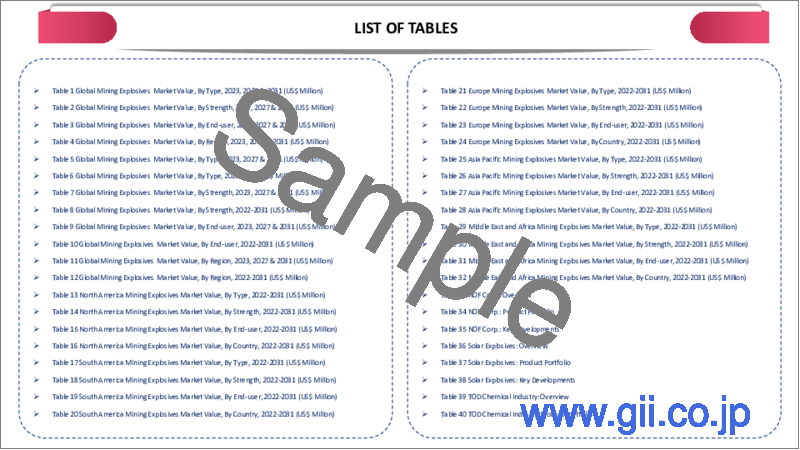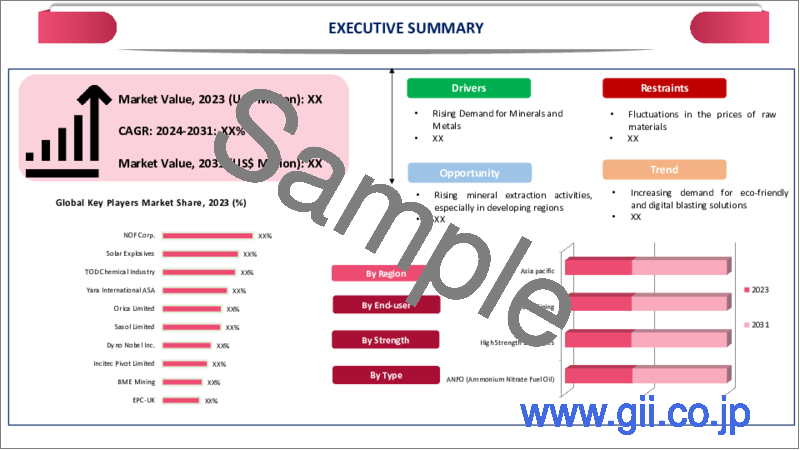|
|
市場調査レポート
商品コード
1290404
鉱業用火薬の世界市場-2023-2030Global Mining Explosive Market - 2023-2030 |
||||||
カスタマイズ可能
適宜更新あり
|
|||||||
| 鉱業用火薬の世界市場-2023-2030 |
|
出版日: 2023年06月12日
発行: DataM Intelligence
ページ情報: 英文 190 Pages
納期: 即日から翌営業日
|
- 全表示
- 概要
- 目次
市場概要
鉱業用火薬の世界市場は、2022年に100億米ドルに達し、2030年には最大300億米ドルに達することで有利な成長を示すことが予測されます。同市場は、予測期間2023年から2030年の間に5.9%のCAGRを示すと予想されています。
石炭採掘、採石、非金属採掘産業からの爆薬需要の高まりにより、鉱業用火薬市場はかなりの拡大が予想されます。鉱業用火薬市場の成長は、鉱業および建設用途における硝酸アンモニウム爆薬の使用量の拡大により発展すると予想されます。
さらに、高度な掘削や発破方法などの採掘技術の技術的進歩により、特殊な鉱業用火薬が必要とされています。これらの進歩は、採掘作業の生産性、効率性、安全性を向上させることを目的としており、鉱業用火薬の需要をさらに促進しています。
市場力学
石炭と鉄鉱石の需要増加
鉄鉱石の需要増加を満たすために、鉱山会社は新しい鉱山に投資し、現在の鉱山を拡張しています。その結果、鉱業用火薬のニーズが高まると予想されます。また、火薬は岩盤を破壊するために使用されるため、採掘の生産性を向上させることが要求され、採掘作業の迅速化・簡素化が図られることも、鉱山用火薬の市場を後押しする要因となっています。
国際エネルギー機関(IEA)によると、世界で最も鉄鋼を消費しているのは建設業で、全体の約50%を占めています。また、鉱業用火薬の市場は、建設業の拡大が牽引しています。建設業の拡大により、セメントや鋼材などの建築資材のニーズが高まっており、これが鉱業用火薬市場の成長を促しています。
高い設備投資と輸送コスト
鉱業用火薬の市場は、資本集約性が高いです。市場参入企業は、新しいアイテムを開発するために多額の資金を費やす必要があります。また、人材育成や産業施設にもお金をかける必要があります。2023年から2030年の予測年では、この要因が市場拡大を妨げると予測されています。
採掘鉱石1トン当たりの運搬・巻上費用は、米国で0.1135~0.4025米ドルです。鉱業用火薬の市場は、高価な輸送によってさらに妨げられています。爆薬は市場参入企業によって遠方の採掘現場まで輸送されなければならず、これは高価なプロセスです。これは、市場拡大を制限する主な要因の1つです。
COVID-19影響分析
COVID-19分析では、COVID前シナリオ、COVIDシナリオ、COVID後シナリオに加え、価格力学(COVID前シナリオと比較したパンデミック中・後の価格変動を含む)、需要-供給スペクトラム(取引制限、ロックダウン、その後の問題による需要と供給のシフト)、政府の取り組み(政府機関による市場、セクター、産業の活性化に関する取り組み)、メーカー戦略的取り組み(COVID問題を軽減するためにメーカーは何を行ったか)についても解説します。
目次
第1章 調査手法とスコープ
- 調査手法
- 調査目的および調査範囲
第2章 市場の定義と概要
第3章 エグゼクティブサマリー
第4章 市場力学
- 市場影響因子
- 促進要因
- 抑制要因
- 機会
- 影響分析
第5章 産業分析
- ポーターのファイブフォース分析
- サプライチェーン分析
- 価格分析
- 法規制の分析
第6章 COVID-19の分析
第7章 タイプ別
- ANFO
- エマルジョン爆薬
- バルク爆薬
- 検定爆薬
- その他
第8章 強度別
- 高強度火薬
- 低強度火薬
第9章 エンドユーザー別
- 石炭鉱業
- 金属鉱業
- 採石・非金属
- 建設業
- その他
第10章 地域別
- 北米
- 米国
- カナダ
- メキシコ
- 欧州
- ドイツ
- 英国
- フランス
- イタリア
- スペイン
- その他欧州
- 南米
- ブラジル
- アルゼンチン
- その他南米地域
- アジア太平洋地域
- 中国
- インド
- 日本
- オーストラリア
- その他アジア太平洋地域
- 中東・アフリカ地域
第11章 競合情勢
- 競合シナリオ
- 市況/シェア分析
- M&A(合併・買収)分析
第12章 企業プロファイル
- Enaex S.A.
- 会社概要
- 製品ポートフォリオと説明
- 財務概要
- 主な発展状況
- NOF Corp.
- Solar Explosives
- TOD Chemical Industry
- Yara International ASA
- Orica Limited
- MaxamCorp. Holding, S.L.
- Austin Powder Company
- Sasol Limited
- Dyno Nobel Inc.
第13章 付録
Market Overview
The Global Mining Explosive Market reached US$ 10 billion in 2022 and is projected to witness lucrative growth by reaching up to US$ 30 billion by 2030. The market is expected to exhibit a CAGR of 5.9% during the forecast period 2023-2030.
Due to the rising demand for explosives from the coal mining, quarrying, and nonmetal mining industries, the mining explosives market is anticipated to experience considerable expansion. The mining explosives market growth is expected to develop due to the expanding usage of ammonium nitrate explosives in mining and construction applications.
Furthermore, Technological advancements in mining techniques, such as advanced drilling and blasting methods, require specialized mining explosives. These advancements aim to improve mining operations' productivity, efficiency, and safety, further fueling the demand for mining explosives.
Market Dynamics
Increasing Demand for Coal and Iron Ore
To fulfill the rising demand for iron ore, mining corporations are investing in new mines and expanding the current mines. The need for mining explosives is anticipated to increase as a result. Another factor propelling the market for mining explosives is the requirement for increased mining productivity since explosives are used to break rock, which facilitates faster and simpler mining operations.
According to the International Energy Agency, construction consumes the most steel globally, making up around 50% of overall use. The market for mining explosives is also being driven by the expanding construction sector. Due to the expanding construction industry, there is a rising need for building supplies like cement and steel, which is driving the mining explosive market growth.
High Capital Investment and Transportation Costs.
The market for mining explosives is highly capital-intensive. The market participants must spend a sizable sum of money to develop new items. They also need to spend money on personnel training and industrial facilities. In the forecast years of 2023-2030, this factor is anticipated to impede market expansion.
The typical haulage and hoisting expenses per ton of mined ore ranged from US$0.1135 to US$0.4025. The market for mining explosives is further hampered by expensive shipping. The explosives must be transported to distant mining sites by market participants, which is an expensive process. This is one of the main factors limiting market expansion.
COVID-19 Impact Analysis
The COVID-19 Analysis includes Pre-COVID Scenario, COVID Scenario and Post-COVID Scenario along with Pricing Dynamics (Including pricing change during and post-pandemic comparing it with pre-COVID scenarios), Demand-Supply Spectrum (Shift in demand and supply owing to trading restrictions, lockdown, and subsequent issues), Government Initiatives (Initiatives to revive market, sector or Industry by Government Bodies) and Manufacturers Strategic Initiatives (What manufacturers did to mitigate the COVID issues will be covered here).
Segment Analysis
The Global Mining Explosive Market is segmented based on type, strength, end-user, and region.
Growing Investments In The Coal Mining Industry Boost The Segmental Growth Of The Market.
The Global Mining Explosive Market has been segmented by end-user into coal mining, metal mining, quarrying and non-metal, construction, and others. The coal mining segment held the largest mining explosive market share of 29.4% in 2022 in the mining explosive market analysis report. In most coal mines, a miner is provided with a detonator and detonating cord to ensure his safety.
Considering a long time ago, coal has been a crucial source of energy. Coal is mostly utilized today to produce steel, electricity, and as a liquid fuel. The majority of the coal produced worldwide comes from China. In 2020, there were 1,074.1 billion tons (Bnt) of coal reserves worldwide. On a long-term basis, the switch to renewable energy is anticipated to substantially affect coal production worldwide.
Geographical Analysis
The Asia-Pacific Held the Largest Share in Mining Explosive Market.
The Global Mining Explosive Market is segmented into five parts of the world based on geography: North America, South America, Europe, Asia Pacific, the Middle East, and Africa. The Asia-Pacific Mining Explosive market held the largest market share of 32.5% in 2022 in the Mining Explosive market analysis.
The increase in demand for commodities used in the mining and metal sectors is due to the expansion of mineral extraction activities in rising economies. For instance, because India is one of the biggest emerging markets in the region, the market for mining explosives in India is expanding at the quickest rate. The Ministry of Mines reports that India's mineral production climbed by 9.7% in November 2022 and by a total of 4.7% from April to November 2022.
Competitive Landscape
The major global players in the market include: Enaex S.A., NOF Corp., Solar Explosives, TOD Chemical Industry, Yara International ASA, Orica Limited, MaxamCorp. Holding, S.L., Austin
Why Purchase the Report?
- To visualize the global mining explosive market segmentation based on type, strength, end-user, and region and understand key commercial assets and players.
- Identify commercial opportunities in the market by analyzing trends and co-development.
- Excel data sheet with numerous data points of mining explosive market-level with all segments.
- The PDF report consists of cogently put-together market analysis after exhaustive qualitative interviews and in-depth market study.
- Product mapping is available as Excel consists of key products of all the major market players.
The Global Mining Explosive Market Report Would Provide Approximately 61 Tables, 59 Figures And 190 pages.
Target Audience 2023
- Manufacturers/ Buyers
- Industry Investors/Investment Bankers
- Research Professionals
- Emerging Companies
Table of Contents
1. Methodology and Scope
- 1.1. Research Methodology
- 1.2. Research Objective and Scope of the Report
2. Market Definition and Overview
3. Executive Summary
- 3.1. Market Snippet, by Type
- 3.2. Market Snippet, by Strength
- 3.3. Market Snippet, by End-User
- 3.4. Market Snippet, by Region
4. Market Dynamics
- 4.1. Market Impacting Factors
- 4.1.1. Drivers
- 4.1.2. Restraints
- 4.1.3. Opportunity
- 4.1.4. Impact Analysis
5. Industry Analysis
- 5.1. Porter's Five Forces Analysis
- 5.2. Supply Chain Analysis
- 5.3. Pricing Analysis
- 5.4. Regulatory Analysis
6. COVID-19 Analysis
- 6.1. Analysis of COVID-19 on the Market
- 6.1.1. Before COVID-19 Market Scenario
- 6.1.2. Present COVID-19 Market Scenario
- 6.1.3. After COVID-19 or Future Scenario
- 6.2. Pricing Dynamics Amid COVID-19
- 6.3. Demand-Supply Spectrum
- 6.4. Government Initiatives Related to the Market During Pandemic
- 6.5. Manufacturers Strategic Initiatives
- 6.6. Conclusion
7. By Type
- 7.1. Introduction
- 7.1.1. Market Size Analysis and Y-o-Y Growth Analysis (%), By Type
- 7.1.2. Market Attractiveness Index, By Type
- 7.2. ANFO (Ammonium Nitrate Fuel Oil*
- 7.2.1. Introduction
- 7.2.2. Market Size Analysis and Y-o-Y Growth Analysis (%)
- 7.3. Emulsion Explosive
- 7.4. Bulk Explosive
- 7.5. Permissible Explosive
- 7.6. Others
8. By Strength
- 8.1. Introduction
- 8.1.1. Market Size Analysis and Y-o-Y Growth Analysis (%), By Strength
- 8.1.2. Market Attractiveness Index, By Strength
- 8.2. High Strength Explosives*
- 8.2.1. Introduction
- 8.2.2. Market Size Analysis and Y-o-Y Growth Analysis (%)
- 8.3. Low Strength Explosives
9. By End-User
- 9.1. Introduction
- 9.1.1. Market Size Analysis and Y-o-Y Growth Analysis (%), By End-User
- 9.1.2. Market Attractiveness Index, By End-User
- 9.2. Coal Mining
- 9.2.1. Introduction
- 9.2.2. Market Size Analysis and Y-o-Y Growth Analysis (%)
- 9.3. Metal Mining
- 9.4. Quarrying and Non-Metal
- 9.5. Construction
- 9.6. Others
10. By Region
- 10.1. Introduction
- 10.1.1. Market Size Analysis and Y-o-Y Growth Analysis (%), By Region
- 10.1.2. Market Attractiveness Index, By Region
- 10.2. North America
- 10.2.1. Introduction
- 10.2.2. Key Region-Specific Dynamics
- 10.2.3. Market Size Analysis and Y-o-Y Growth Analysis (%), By Type
- 10.2.4. Market Size Analysis and Y-o-Y Growth Analysis (%), By Strength
- 10.2.5. Market Size Analysis and Y-o-Y Growth Analysis (%), By End-User
- 10.2.6. Market Size Analysis and Y-o-Y Growth Analysis (%), By Country
- 10.2.6.1. The U.S.
- 10.2.6.2. Canada
- 10.2.6.3. Mexico
- 10.3. Europe
- 10.3.1. Introduction
- 10.3.2. Key Region-Specific Dynamics
- 10.3.3. Market Size Analysis and Y-o-Y Growth Analysis (%), By Type
- 10.3.4. Market Size Analysis and Y-o-Y Growth Analysis (%), By Strength
- 10.3.5. Market Size Analysis and Y-o-Y Growth Analysis (%), By End-User
- 10.3.6. Market Size Analysis and Y-o-Y Growth Analysis (%), By Country
- 10.3.6.1. Germany
- 10.3.6.2. The U.K.
- 10.3.6.3. France
- 10.3.6.4. Italy
- 10.3.6.5. Spain
- 10.3.6.6. Rest of Europe
- 10.4. South America
- 10.4.1. Introduction
- 10.4.2. Key Region-Specific Dynamics
- 10.4.3. Market Size Analysis and Y-o-Y Growth Analysis (%), By Type
- 10.4.4. Market Size Analysis and Y-o-Y Growth Analysis (%), By Strength
- 10.4.5. Market Size Analysis and Y-o-Y Growth Analysis (%), By End-User
- 10.4.6. Market Size Analysis and Y-o-Y Growth Analysis (%), By Country
- 10.4.6.1. Brazil
- 10.4.6.2. Argentina
- 10.4.6.3. Rest of South America
- 10.5. Asia-Pacific
- 10.5.1. Introduction
- 10.5.2. Key Region-Specific Dynamics
- 10.5.3. Market Size Analysis and Y-o-Y Growth Analysis (%), By Type
- 10.5.4. Market Size Analysis and Y-o-Y Growth Analysis (%), By Strength
- 10.5.5. Market Size Analysis and Y-o-Y Growth Analysis (%), By End-User
- 10.5.6. Market Size Analysis and Y-o-Y Growth Analysis (%), By Country
- 10.5.6.1. China
- 10.5.6.2. India
- 10.5.6.3. Japan
- 10.5.6.4. Australia
- 10.5.6.5. Rest of Asia-Pacific
- 10.6. Middle East and Africa
- 10.6.1. Introduction
- 10.6.2. Key Region-Specific Dynamics
- 10.6.3. Market Size Analysis and Y-o-Y Growth Analysis (%), By Type
- 10.6.4. Market Size Analysis and Y-o-Y Growth Analysis (%), By Strength
- 10.6.5. Market Size Analysis and Y-o-Y Growth Analysis (%), By End-User
11. Competitive Landscape
- 11.1. Competitive Scenario
- 11.2. Market Positioning/Share Analysis
- 11.3. Mergers and Acquisitions Analysis
12. Company Profiles
- 12.1. Enaex S.A.
- 12.1.1. Company Overview
- 12.1.2. Product Portfolio and Description
- 12.1.3. Financial Overview
- 12.1.4. Key Developments
- 12.2. NOF Corp.
- 12.3. Solar Explosives
- 12.4. TOD Chemical Industry
- 12.5. Yara International ASA
- 12.6. Orica Limited
- 12.7. MaxamCorp. Holding, S.L.
- 12.8. Austin Powder Company
- 12.9. Sasol Limited
- 12.10. Dyno Nobel Inc.
LIST NOT EXHAUSTIVE
13. Appendix
- 13.1. About Us and Services
- 13.2. Contact Us





